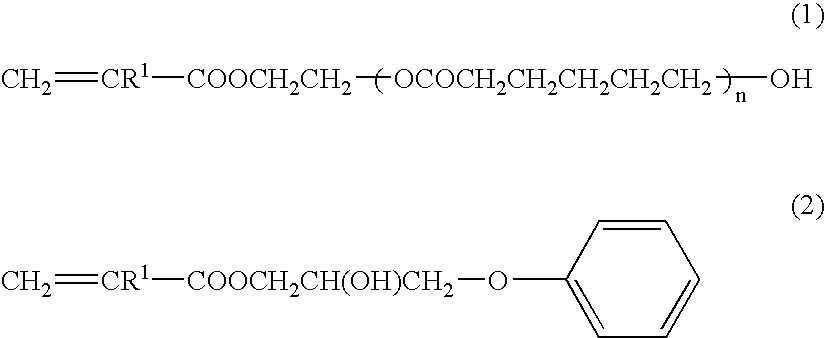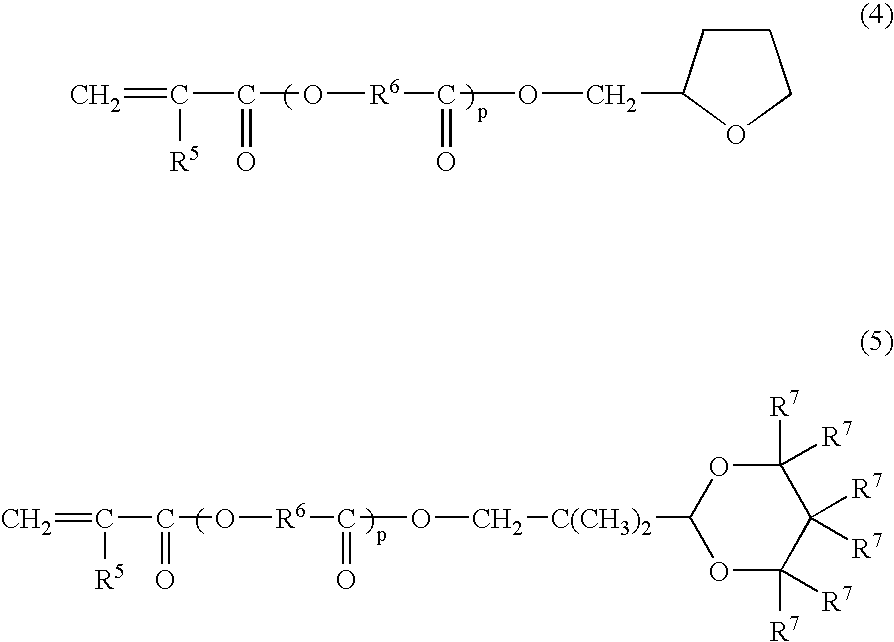Curable liquid resin composition
a liquid resin and composition technology, applied in the field can solve the problems of limited rheological compatibility, affecting the stability of liquid resin compositions, and often affecting the stability of processability, and achieves the effects of enhancing liquid elasticity, high steady state compliance, and processing of combinations of primary and secondary resin compositions
- Summary
- Abstract
- Description
- Claims
- Application Information
AI Technical Summary
Benefits of technology
Problems solved by technology
Method used
Image
Examples
preparation example 1
Preparation of urethane(meth)acrylate (A)
[0058]A reaction vessel equipped with a stirrer was charged with 18.94 g of isophorone diisocyanate, 0.013 g of 2,6-di-t-butyl-p-cresol, 0.042 g of dibutyltin dilaurate, and 0.004 g of phenothiazine. The mixture was cooled with ice to 10° C. or below while stirring. After the addition of 17.66 g of a ring-opening polymer of propylene oxide with a number average molecular weight of 1,000, the mixture was reacted with stirring for two hours while controlling the liquid temperature at 35° C. or lower. Then, 15.71 g of hydroxyethyl acrylate was added dropwise and the mixture was stirred for 3 hours at 70-75° C. The reaction was terminated when the residual isocyanate content was 0.1 wt % or less. This liquid resin is designated as AU-1.
preparation example 2
Preparation of urethane(meth)acrylate (A)
[0059]A reaction vessel equipped with a stirrer was charged with 28.590 g of 2,4-toluene diisocyanate, 0.021 g of 2,6-di-t-butyl-p-cresol, 0.072 g of dibutyltin dilaurate, and 0.007 g of phenothiazine. The mixture was cooled with ice to 10° C. or below while stirring. After the addition of 26.450 g of a ring-opening polymer of propylene oxide with a number average molecular weight of 2,000, the mixture was reacted with stirring for two hours while controlling the liquid temperature at 35° C. or lower. Then, 9.700 g of 2-hydroxypropyl acrylate was added dropwise. After further adding 24.740 g of hydroxyethyl acrylate dropwise, the mixture was stirred for 3 hours at 70-75° C. The reaction was terminated when the residual isocyanate content was 0.1 wt % or less. This liquid resin is designated as AU-2.
preparation example 3
Preparation of urethane(meth)acrylate (A)
[0060]A reaction vessel equipped with a stirrer was charged with 28.6 g of 2,4-toluene diisocyanate, 0.02 g of 2,6-di-t-butyl-p-cresol, 0.07 g of dibutyltin dilaurate, and 0.007 g of phenothiazine. The mixture was cooled with ice to 10° C. or below while stirring. After the addition of 53.4 g of a ring-opening polymer of tetrahydrofuran with a number average molecular weight of 650 (PTHF-650), the mixture was reacted with stirring for two hours while controlling the liquid temperature at 35° C. or lower. Then, 19.1 g of 2-hydroxypropyl acrylate was added dropwise. The mixture was stirred for 3 hours at 70-75° C. The reaction was terminated when the residual isocyanate content was 0.1 wt % or less. This liquid resin is designated as AU-3.
PUM
| Property | Measurement | Unit |
|---|---|---|
| Young's modulus | aaaaa | aaaaa |
| thickness | aaaaa | aaaaa |
| temperature | aaaaa | aaaaa |
Abstract
Description
Claims
Application Information
 Login to View More
Login to View More - R&D
- Intellectual Property
- Life Sciences
- Materials
- Tech Scout
- Unparalleled Data Quality
- Higher Quality Content
- 60% Fewer Hallucinations
Browse by: Latest US Patents, China's latest patents, Technical Efficacy Thesaurus, Application Domain, Technology Topic, Popular Technical Reports.
© 2025 PatSnap. All rights reserved.Legal|Privacy policy|Modern Slavery Act Transparency Statement|Sitemap|About US| Contact US: help@patsnap.com



